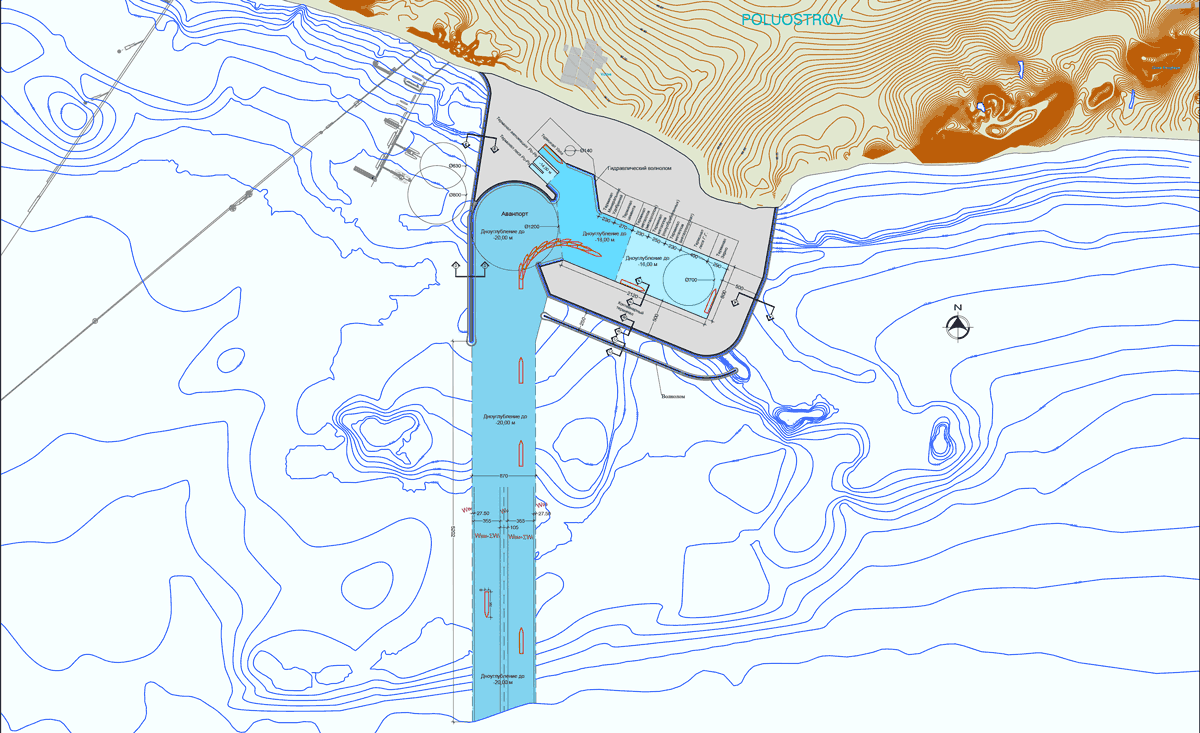Feasibility Study of the investments for the Project: “Set-up of the Dry Cargo Handling Area of the Taman Seaport”
Client: Ministero dei Trasporti della Federazione Russa
Period of implementation: 2007
Total value of works: Rubli 60 x 10^9
Value of our services: Euro 283.187,00
The following activities were involved in the drawing up of the Feasibility Study.
Preliminary analyses
Under the Feasibility Study the following preliminary studies were conducted.
Market analysis, forecast of transport demand and main characteristics of the complex
The main aim of this activity was to define a forecast scenario for each type of cargo that must be handled in the Port of Taman. The results of this activity were indispensable for the correct development of the entire work.
Estimate of technical and infrastructure extensions
The aim of this activity was to provide an estimate of the extensions necessary for building a terminal designed to support and handle the volumes of cargo calculated.
PEST and SWOT analysis
The aim of this activity was to create a socio-economic frame of reference to assess the desirability of making a large investment in the construction of the new port in the Taman Peninsula area. This activity has two parts:
- PEST – Political, Economic, Social and Technological Analysis;
- SWOT – Strengths, Weaknesses, Opportunities and Threats Analysis.
Identification of the preliminary design hypotheses
The aim of this activity was to analyze, compare and finally assess the various possible locations, in order to identify the one which, on the basis of certain evaluation criteria identified, could be the best location choice from the viewpoint of the construction, and above all, for the aspects related to the environment, operations and the economic and financial return. In particular, the following zones were analyzed:
- Tuzla dam: the area is just to the north of the Tuzla strip, in the Gulf of Taman;
- Cape Panagia: the area is just to the south of the Tuzla spit, between Cape Panagia and Cape Tuzla, near the approach route to the Kerch Strait;
- Togliatti-Azot and Tamaneftgas jetties: the area is between the existing port facilities and those under construction, between Cape Panagia to the west and the Iron Horn to the east;
- Iron Horn: the area is located immediately to the east of the Iron Horn;
- Lake Solenoe: the area identified is in Lake Solenoe.
Evaluation and selection of the preliminary design hypotheses
The aim of this activity, taking into account the elements emerging in the preliminary analyses of the study, was to identify the locations unable to fulfil the strategic role and Federation significance of the new port for dry cargo in Taman.
Further technical studies and extra investigations
After completion of the preliminary studies, the two design solutions (Cape Panagia and Iron Horn) covered in the technical studies and extra investigations were chosen and are discussed in this chapter.
Geotechnical and hydrographic analyses
The aim of this activity was to provide the main elements for the geological, geotechnical, hydrographic and marine weather aspects, in order to be able to locate the port in the best way and to set out technically sustainable layout hypotheses.
Preliminary design for alternative solutions
The aim of this study was the definition of the preliminary design for the Port of Taman, for the two alternatives selected. The activity was completed with the definition of the outline of technical requirements for processing the project documentation; from the methodological point of view, the work was undertaken according to the most modern and advanced standards of design, taking into account the legislation in force in the territory of the Russian Federation.
Zoning of the port areas and transport routes
The aim of the activity was the definition of the main layout for the Port of Taman, for the two alternatives considered.
Road and rail access
The activity was dedicated to the definition of the road and rail accesses to the new Port of Taman, in order to guarantee the possibility of ensuring traffic to and from the port in such a way as to meet the transport demand hypothesized in the project. The best road and rail routes and their cost were identified for each location.
Environmental impact study
The aim of this activity was the evaluation of the environmental impact produced by the works contained in this project, in order to ensure that man-made activities are compatible with the conditions for a sustainable development, respecting the regenerative capacity of the ecosystems and resources, the protection of biodiversity and of the equal distribution of the advantages connected with the economic activity.
With reference to the interventions involved in the two alternatives selected, the environmental issues were analyzed for each component, starting from the definition of the reference zero option, estimating the expected impact of the operational situation (final configuration) and during implementation of the works.
The environmental components involved are:
- Atmosphere
- Water resources
- Soil and subsoil
- Flora and fauna
- Marine environment
- Health and socio-economic conditions in the construction area.
Analysis of project and operating costs
The aim of the activity was the estimate the costs for construction and operation of the Port of Taman, in the two location hypotheses;
Calculation of the efficiency of the project and risk analysis
The aim of the activity was to provide an evaluation of the economic and financial feasibility of the Dry Cargo Handling Area of the Taman Seaport. The two construction options identified were assessed according to the four sub-criteria of “economic-financial return”, shown below:
- Net Present Value (NPV), given by discounting (to year zero) the annual differences between the benefits and costs to be incurred for the construction, management and maintenance of the port in the period considered for the evaluation;
- Internal Rate of Return (IRR), i.e. the rate of the discount rate brining the NPV to zero;
- Pay-Back Period (PBP), i.e. the time (in years) when it is estimated that the capital invested initially will be recovered;
- Return on Investment (ROI), showing the economic return and efficiency of the operational management independently from the sources utilized.
Identification of the project solution
The definition of the layout of the new port of Taman is based on the analysis of various aspects:
- economic and financial aspects;
- possibility of port development;
- manoeuvrability during access by the ships;
- availability of areas equipped for industrial use in the zone adjacent to the port;
- efficiency of logistics during construction.
For the solution identified, a design was provided for the maritime works, the various existing terminals, plant, buildings and the upgrading of road and rail infrastructures.
The estimate of the construction costs of the future maritime terminal of Taman was conducted in accordance with the method of definition of costs applied in the construction sector on the territory of the Russian Federation.




